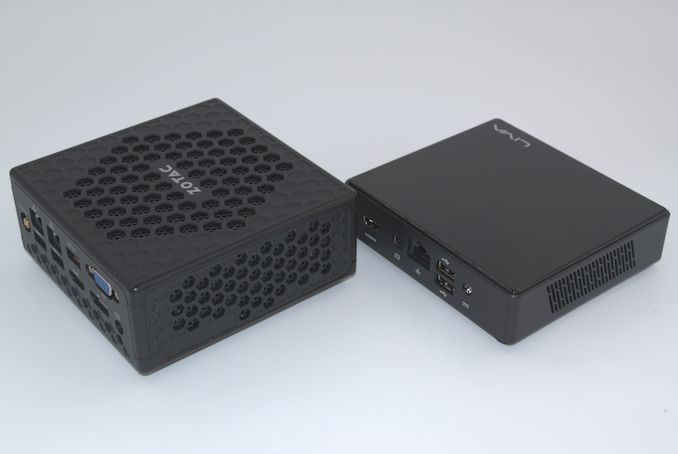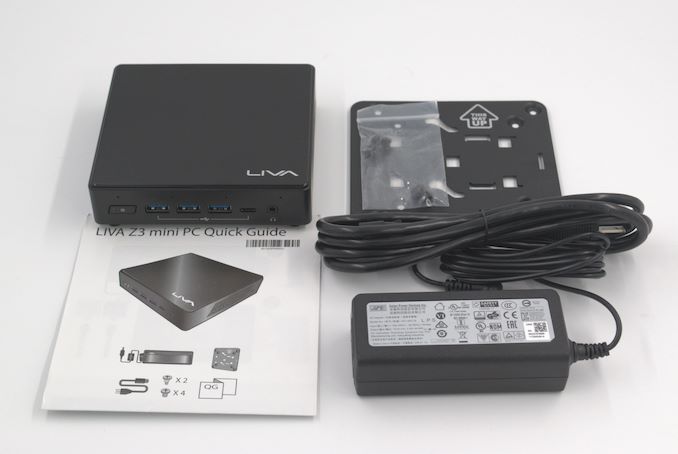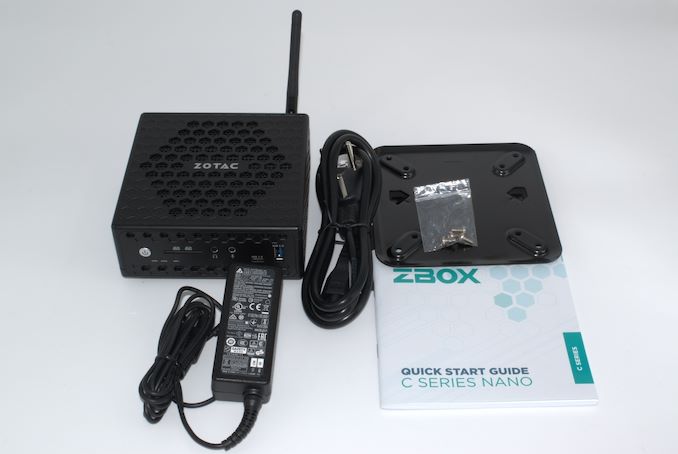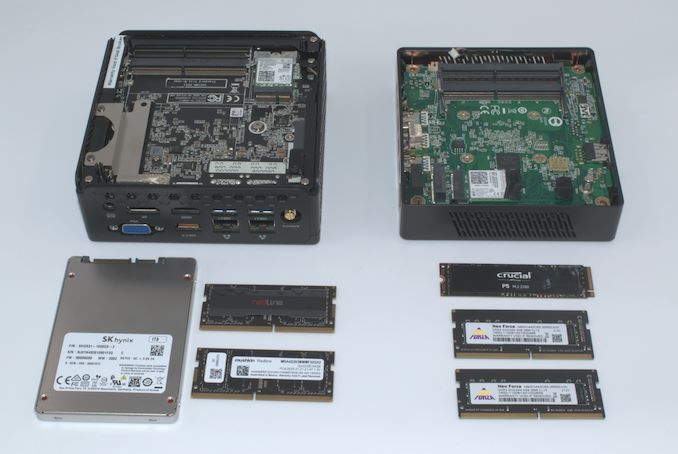Jasper Lake Fanless Showdown: ECS LIVA Z3 and ZOTAC ZBOX CI331 nano UCFF PCs Review
by Ganesh T S on July 8, 2022 8:30 AM EST- Posted in
- Systems
- ZOTAC
- Fanless
- ECS
- Passive Cooling
- UCFF
- Mini-PC
- Jasper Lake

Intel's Jasper Lake series of products (based on the Tremont microarchitecture) was launched in early 2021. Since then, we have seen a steady stream of notebooks and motherboards / mini-PCs based on those processors getting introduced in the market. Ultra-compact form-factor (UCFF) machines based on the Atom series offer attractive entry-level options in the NUC domain. Their low-power nature also lends itself to passively cooled designs.
Intel's Jasper Lake SKUs are a follow-up to Gemini Lake. Back in 2018, we had reviewed two different Gemini Lake UCFF PCs - the actively cooled June Canyon NUC from Intel, and the passively cooled LIVA Z2 from ECS. For Jasper Lake, we have sourced four different UCFF PCs - two passively cooled systems using 6W TDP processors, and two actively cooled ones using 10W TDP processors.
Today's article provides a detailed look into the performance and features of the two passively cooled systems - the ECS LIVA Z3 and the ZOTAC ZBOX CI331 nano. Both of them are based on 6W TDP processors, with slight variations in frequency and iGPU capabilities. The two vendors have also adopted different approaches to the power limits, making for unexpected performance impacts. In addition to an investigation into the capabilities offered for traditional PC workloads, we also go deep into the thermal design to provide insights into what makes fanless systems satisfy user requirements.
Introduction and Product Impressions
Intel's Apollo Lake SoCs (Goldmont-based) introduced in 2016 were quickly followed by Gemini Lake (Goldmont Plus) in late 2017. However, the delays related to 10nm manufacturing resulted in a significant gap before the Tremont-based Jasper Lake products made an appearance in early 2021. Compared to Gemini Lake, the new Jasper Lake products have improved CPU performance (Intel claims a 33% uplift) with an updated microarchitecture and larger caches. The integrated GPU is also clocked higher with additional EUs. Intel On the system front, faster expansion options are available, with up to 8 Gen 3 lanes (compared 6 Gen 2 lanes in Gemini Lake), 14 USB ports (up to 10 Gbps) (compared to 8 ports up to 5 Gbps in Gemini Lake). Jasper Lake also integrates a Wireless-AX MAC, allowing for cost-effective systems with Wi-Fi 6 support. Manufacturers can adopt or take advantage of these features in a varied manner to bring differentiated products into the market.
Similar to our Apollo Lake (Intel Arches Canyon and ECS LIVA Z) and Gemini Lake (Intel June Canyon and ECS LIVA Z2) experiments, we got hold of multiple Jasper Lake UCFF PCs for evaluation. Today's review is focused on the two fanless systems - the ECS LIVA Z3 and the ZOTAC ZBOX CI331 nano.
A quick comparison of the ECS LIVA Z3 and the ZBOX CI331 nano reveal the following differentiation aspects:
- Support for a 2.5" SATA disk drives in the ZBOX, not available in the LIVA Z3
- Support for a M.2 2280 NVMe SSD in the LIVA Z3, not available in the ZBOX
- Integrated 128GB eMMC in the LIVA Z3, not available in the ZBOX
- VGA display output (total of 3, including HDMI and DisplayPort) available in the ZBOX, while the LIVA Z3 has only two (HDMI and mini-DP)
- Dual LAN and SDXC/SDHC card reader included in the ZBOX, while the LIVA Z3 has only a single LAN port
- Integrated quad-microphone (DMIC) array in the LIVA Z3, while the ZBOX has separate headphone and microphone jacks.
The ZBOX also uses a more advanced WLAN solution (Intel Wireless-AC 9462 with Bluetooth 5.1) compared to the LIVA Z3 (Intel Wireless-AC 3165 with Bluetooth 4.2). The form-factors are also slightly different, with the absence of 2.5" disk drive support in the LIVA Z3 enabling it to be slimmer.
The LIVA Z3 comes in multiple flavors - an OS-less version with 4GB of RAM and 128GB eMMC for $220, and another variant with Windows 10 Pro bundled for $250. The ZBOX CI331 nano also has a similar bundle, though the barebones version is sans memory or eMMC. Pricing comes in at $260 for the barebones version. The reasons for the pricing premium will become apparent as we proceed through the review.
The use-cases for the two systems are manifold, with the fanless nature making them suitable for digital signage, kiosks, retail applications, etc. The dual LAN feature in the ZBOX makes it additionally attractive for networking applications.
The system packages delivered by ECS and ZOTAC are similar - both include a 65W power adapter (19V @ 3.42A), and include VESA mounts. The ZOTAC package includes a separate WLAN antenna, and additional thermal pads for the SATA drive.
The ECS LIVA Z3 review sample came with both memory slots occupied (2x 4GB DDR4-2666 SODIMMs). The board also includes 128GB eMMC, but that is insufficient for our benchmarking purposes. We took advantage of the M.2 NVMe slot to install a Crucial P5 M.2 2280 NVMe SSD in the system as the primary drive. The full specifications of the ECS LIVA Z3 sample as tested are provided in the table below.
| ECS LIVA Z3 Specifications (as tested) |
|
| Processor | Intel Pentium Silver N6000 Jasper Lake 4C/4T, 1.1 - 3.3 GHz Intel 10nm, 4MB L3, 6W |
| Memory | Gold Key Tech. Neo Forza NMSO440D85-2666E DDR4-2666 SODIMM 19-19-19-43 @ 2666 MHz 2x4 GB |
| Graphics | Intel UHD Graphics (32EU @ 350 - 850 MHz) |
| Disk Drive(s) | Crucial P5 CT1000P5SSD8 (1 TB; M.2 2280 PCIe 3.0 x4 NVMe;) (Micron 96L 3D TLC; Micron DM0182 Controller) Biwin BWCTASC41P128G (128GB; eMMC) |
| Networking | 1x GbE RJ-45 (Realtek RTL8168/8111) Intel Wireless AC-3165 (1x1 802.11ac - 433 Mbps) |
| Audio | Realtek ALC897 (3.5mm Headphone Jack in Front Panel with Quad-Mic Array Digital Microphon) Digital Audio and Bitstreaming Support over HDMI and DisplayPort Outputs |
| Video | 1x HDMI 2.0a 1x mini-DP 1.4a |
| Miscellaneous I/O Ports | 3x USB 3.2 Gen 1 Type-A (Front) 1x USB 3.2 Gen 2 Type-C (Front) 2x USB 2.0 Type-A (Rear) |
| Operating System | Windows 11 Enterprise (22000.708) |
| Pricing | (Street Pricing on June 21st, 2022) US $232 (w/eMMC, 4GB DDR4, and OS) US $352 (as configured) |
| Full Specifications | ECS LIVA Z3 Specifications |
The ZOTAC ZBOX CI331 nano was a barebones sample, similar to the CI662 nano we reviewed last year. Zotac's C series eschews M.2 slots and opts instead for the traditional 2.5" SATA drive bay. The SSD used in that review (SK hynix Gold S31) was reused in the CI331 nano. The DRAM option was more tricky. The Jasper Lake platform officially supports DDR4-2933. Having a large number of DDR4-2933 / DDR4-3000 / DDR4-3200 SODIMMs collected (starting from the Skylake days), I was hopeful of getting one of those early high-frequency SODIMMs to operate at DDR-2933 speeds in the CI331 nano. Unfortunately, they all defaulted to DDR-2400, and the BIOS was not too helpful in terms of allowing modification of DRAM timings. Only recent DDR4-2933+ SODIMMs were able to operate at DDR-2933 in the system - unfortunately, I only had 32GB SODIMMs in hand from the recent batches. In the end, the ZBOX CI331 nano was outfitted with 2x 32GB DDR-2933 Mushkin Redline SODIMMs for a total of 64GB of RAM - way higher than the officially specified 16GB maximum memory capacity of the Jasper Lake platform. Fortunately, the system worked flawlessly through our benchmarking routines despite this wild configuration. The full specifications of the ZOTAC ZBOX CI331 nano sample as tested are provided in the table below.
| ZOTAC ZBOX CI331 nano Specifications (as tested) |
|
| Processor | Intel Celeron N5100 Jasper Lake 4C/4T, 1.1 - 2.8 GHz Intel 10nm, 4MB L3, 6W |
| Memory | Mushkin MR[ABC]4S293MMMF32G DDR4-2933 SODIMM 21-21-21-47 @ 2933 MHz 2x32 GB |
| Graphics | Intel UHD Graphics (24EU @ 350 - 850 MHz) |
| Disk Drive(s) | SK hynix Gold S31 (1 TB; 2.5" SSD SATA III;) (SK hynix 72L 3D TLC; SK hynix Quartz SH87830CC Controller) |
| Networking | 2x GbE RJ-45 (Realtek RTL8168/8111) Intel Wireless AC-9462 (1x1 802.11ac - 433 Mbps) |
| Audio | ESS Tech ES9270 USB DAC (3.5mm Audio Jacks in Front Panel) Digital Audio and Bitstreaming Support over HDMI and DisplayPort Outputs |
| Video | 1x HDMI 2.0b 1x DisplayPort 1.2 1x VGA |
| Miscellaneous I/O Ports | 1x USB 3.2 Gen 1 Type-A (Front) 1x USB 3.2 Gen 1 Type-C (Front) 2x USB 3.2 Gen 2 Type-A (Rear) 1x USB 3.2 Gen 1 Type-A (Charging / Rear) 1x SDXC/SDHC UHS-I Card Reader Slot (Front) |
| Operating System | Windows 11 Enterprise (22000.708) |
| Pricing | (Street Pricing on July 6st, 2022) US $260 (barebones) US $616 (as configured) |
| Full Specifications | ZOTAC ZBOX CI331 nano Specifications |
Our next section goes into the details of the thermal design and the need for a thorough look at it.














52 Comments
View All Comments
ganeshts - Wednesday, July 13, 2022 - link
Are you aware of any boards / PCs with Elkhart Lake that supports in-band ECC? Vendors I talk to seem to indicate that there is some other feature X that gets disabled if you do in-band.. and that feature X is more important for their target market compared to in-band ECC. So, they do not enable in-band ECC in their products even if the processor supports it.mode_13h - Thursday, July 14, 2022 - link
> Are you aware of any boards / PCs with Elkhart Lake that supports in-band ECC?Sorry, I've not seriously investigated the matter.
> Vendors I talk to seem to indicate that there is some other feature X
> that gets disabled if you do in-band.
Wow. I'd love to know more! I figured the main tradeoff was just one of performance (and probably a less significant hit on memory capacity). I wonder why they don't just make it a user-configurable option.
TBH, I don't know specifics about how Intel implements it. I *assume* they simply set aside a chunk of physical address space to hold the ECC bits for the rest of the address space, but that's just a guess.
ganeshts - Tuesday, July 12, 2022 - link
Looks like you will leave me with nothing to write about for the Atlas Canyon review coming up later this week :)abufrejoval - Thursday, July 14, 2022 - link
If you keep me updated on the things in your pipeline, I'll make sure not to spoil things ;-)mode_13h - Thursday, July 14, 2022 - link
But I love your posts! I'll bet < 1% of the article readers look this deep into the comments.mode_13h - Wednesday, July 13, 2022 - link
Nice review!I had one of those ASRock Apollo Lake boards, but never got it to work. It's possible the RAM I got was incompatible, but it was decent quality (Crucial, IIRC) and their website claimed it worked with that board.
I was sad to see ASRock has no Jasper Lake-based successor, but TBH I'd rather have Elkhart Lake and its in-band ECC-support. I'm just now noticing that Asrock Industrial has some tasty looking options, there. Now, if I can just figure out where to buy a IMB-1003D...
abufrejoval - Thursday, July 14, 2022 - link
NUCs can take quite a while for the initial boot, even the Core based models.If I hadn’t been distracted at the time, I’d have already given up on the Jasper Lake NUC working with 64GB: I had been ready to turn it off by the time it showed the logo! Must have lasted something like 30 seconds or so, just to test and tune the RAM, which was DDR4-3200 after all and not quite the DDR4-2900 specs it officially prefers.
Actually, I really hate that vendors increasingly just program at most 2 settings into DIMMs these days, so you can’t recycle them on a different machine.
Once you realized that bits can rot, it’s very difficult to forego ECC. The very first IBM-PCs had parity and I’m not sure when it got dropped from mainline. Once I started running PCs as home servers, I’ve tried to make sure they had ECC memory. My workstations are also all 128GB ECC.
I bought the Atoms mostly to run QA for oVirt, not as a “production” platform: low cost and low power was key, ECC simply not an economically viable option.
They have been running non-stop for years now, with a collective 128GB of RAM and no glitch that I have ever noticed...
The first time I ever heard of inline ECC was in one of your posts here. After a short moment of “bug-eyed disbelief” it seemed to make sense in an era, when little ever happens in RAM below the granularity of a cache line: the days of truly random RAM where all accesses were equally …slow are long past us, I believe the original Compaq 386 was the first to exploit static column RAM.
I believe RAM compression was also implemented by an IBM server chipset many years ago, memory encryption is available on every modern laptop, so inline ECC seems very believable and not extremely costly: I’d just love to have the choice!
As a matter of fact, this gets me asking: Core chips seem to employ ECC practically everywhere on internal registers, caches and data paths, but do Atoms do likewise? I’d guess they would have to for the server variants, so leaving that out for the entry level chips seems almost extra effort, yet I can’t recall hearing any mention one way or another.
I’ve been trying to buy an Alder Lake replacement for a Haswell Xeon server with ASRocks IMB-X1712 mainboard mentioned here that supports DDR4-3200 ECC RAM. Unfortunately that’s another phantom product that never seems available for sale.
mode_13h - Thursday, July 14, 2022 - link
> Must have lasted something like 30 seconds or so, just to test and tune the RAMDoes the BIOS have an option to disable it, or at least a "fast boot" option?
> Once you realized that bits can rot, it’s very difficult to forego ECC.
The places where you really want ECC are those where a memory error can get persisted in data of non-trivial value. On fileservers and database servers, it's a must (unless the data is virtually disposable or they're simply providing read-only access).
In the worst case, a memory error can actually cause filesystem corruption. It's unlikely, but the thing to remember about memory errors is that they're not entirely random or isolated. A DRAM chip could conceivably fail in a way that suddenly results a large number of memory errors. This will usually crash the machine (if not using ECC), but you could plausibly suffer data corruption just before that happens.
> I bought the Atoms mostly to run QA for oVirt
My ASRock board was meant to replace my Raspberry Pi as a streaming media server, for in-home use.
> The first time I ever heard of inline ECC was in one of your posts here.
I'm pretty sure the first I'd heard of it was on here, as well. I had a similar reaction as yours, but the more I thought about it, the more sense it made. It'd be hard for me to prefer it when I could have the real deal, but not a bad compromise on something like an Atom-tier platform.
> little ever happens in RAM below the granularity of a cache line
Yeah, you could implement it by blocking off 1/8th of RAM (in truth, you'd only need 1/9th, but 1/8th would keep things aligned more nicely) and associating 8 bytes of ECC information per 64-bytes of physical address space. Depending how you implement it, the hit to memory bandwidth could be as little as 11%, for linear accesses.
TBH, I'm a little more mystified by the concept of memory compression. I guess it'd have to be block based, perhaps decompressing whole pages at a time? Then, when you page fault, some kind of index tells you where the page starts. There'd no doubt be some padding or unused space between the pages (or whatever granularity the blocks are). Perhaps the more interesting aspect would be deciding where to write newly-compressed pages.
Of the three, memory encryption seems the most straight-forward. You would likely have a 1:1 mapping, so the only tricky part is one of key management.
> Unfortunately that’s another phantom product that never seems available for sale.
I'll bet availability is being hampered by just a couple key components being extremely hard to source. I heard some motherboard vendors have been unable to source certain Ethernet MACs. Another example I've heard is RAID controllers.
abufrejoval - Thursday, July 14, 2022 - link
>> Must have lasted something like 30 seconds or so, just to test and tune the RAM>Does the BIOS have an option to disable it, or at least a "fast boot" option?
That was only ever an issue for the initial boot with that RAM. Once it has figured out the RAM speed settings any normal boot is at reasonable speeds.
I've research the Elkhart Lake Atoms a bit and they seem quite hard to find. Embedded systems with them sell for eye watering prices.
ZFS was always the typical example for why bit flips could have catastrophical consequences when you cache aggressively and keep key data structure in RAM for months or longer.
I use GlusterFS with VDO de-dup and compression on the Atoms, where a single bit flip could have similarly drastic consequences, but so far I've noticed no issue.
It seems that getting a low power ECC platform is intentionally made difficult, closest I've recently got was with Ryzen 5750G APUs, which isn't that low power nor that cheap.
DDR5 with real ECC seems even worse which is why the ASRock board with the W680 chipset and DDR4 support seems so attractive... and unavailable!
RAM compression: It definitely requires OS support, but other than that seems not too difficult to do. I saw a demo booth at the HiPEAC 2020 conference in Bologna from a Swedish startup I believe, that tries to sell the IP e.g. for integration in RISC-V.
mode_13h - Friday, July 15, 2022 - link
> Elkhart Lake Atoms a bit and they seem quite hard to find.They exist, if expensive and uncommon: https://www.newegg.com/p/1JW-003Z-00026
According to the manufacturer's site, it even seems to support in-band ECC:
https://www.mitacmct.com/IndustrialMotherboard=PD1...
However, that would seem to require the PD10EHI-X6413E model, which is *not* so readily available.
> ASRock board with the W680 chipset
Yeah, I was starting to browse for W680 boards, recently. I wish I could find an ATX (or micro-ATX) with 2x DDR5 slots, but every one I've found is either DDR4 or 4x DDR5 slots. Anyway, I'm not really in a hurry.
> RAM compression: ... seems not too difficult to do.
> ...a Swedish startup ... that tries to sell the IP
Okay, think about that for a second. Someone thought it offered enough value and is sufficiently hard that they started a company around it!